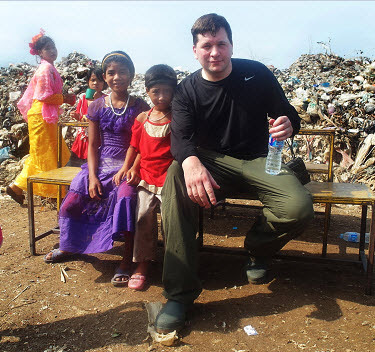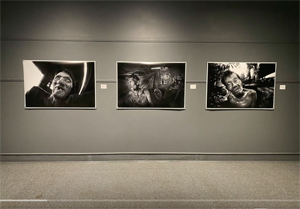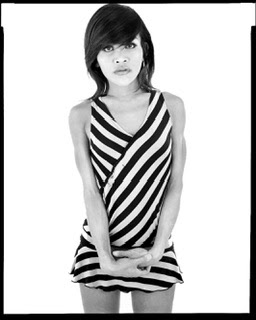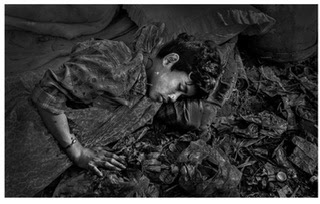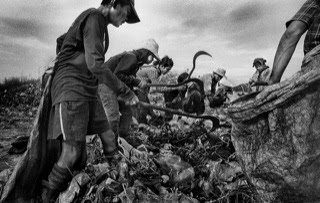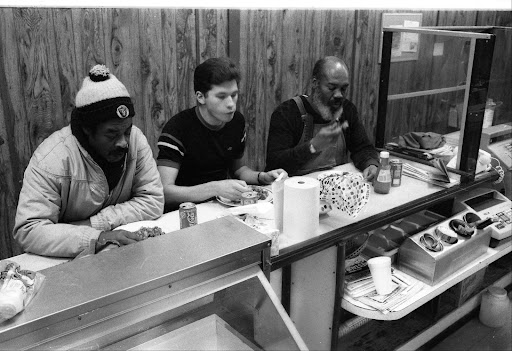Sunday, June 29, 2008
Notebook and Sound
Going to do what I did on other trips and fill a notebook with names, things said and ideas. Hopefully it will help me focus my thoughts, before, during and after the shoots. I am also thinking of doing a series of sound recordings of the photo sessions. I could use the quotes in a possible future book as well as post sound files on my website to make things more interactive and interesting for visitors.
Restless
Images flashing through my mind, feel uneasy and jumpy, cannot relax. Soon I will be on the streets with my camera speaking Thai (or at least trying) in search of people to photograph. I so want and need to make some important photographs. Maybe I am expecting to much for a 3 week window of photo taking but I need to get out there and start shooting.
Redefining Normal: Diane Arbus
Redefining Normal: Diane Arbus
By Greta Berman
As March is Women's History Month, I thought I would focus on an exhibition showing one woman's depiction of "the family." However, if you go to this show expecting to see warm and cuddly family albums of "normal" people, you will be in for a surprise.

Jayne Mansfield Cimber-Ottaviano, actress, with her daughter Jayne Marie, thirteen, 1965 (Copyright © Estate of Diane Arbus, 1965. Esquire Collection, Spencer Museum of Art, the University of Kansas)
It has been said that the definition of "normal" is someone you don't know very well. But for Diane Arbus, this was particularly true. Using her camera as a tool, she probed beneath any veneer of "normalcy." Through her photography, she demonstrated her considered opinion: "I think all families are creepy in a way." In fact, she seemed to find most challenging those families held together by blood, marriage, and law, often portraying alternative "families" in a more sympathetic light. Three years before committing suicide in 1968, she wrote that she was compiling her photos into a "family album," likening it to a Noah's Ark, in which to preserve images of creatures soon to be extinct. It is this never-completed project that comprises the current show at N.Y.U.'s Grey Gallery. The curators organized the exhibition by dividing it into subcategories labeled "Mothers," "Fathers," "Children," "Partners," and "Families."

Madalyn Murray in her bedroom, 1964 (Copyright © Estate of Diane Arbus, 1964. Esquire Collection, Spencer Museum of Art, the University of Kansas)
It is fascinating to examine the 57 contact sheets—many shown for the first time in this exhibition—and guess which shots Arbus would select for printing. Inevitably she chose the ones featuring uncomfortable, even freaky-looking people in awkward poses. She neither manipulated images nor employed gimmicks, but simply set up the scenes, culling from them those best illustrating her own view.
Among the mothers she chose, Marguerite Oswald (mother of alleged Kennedy assassin Lee Harvey Oswald) and Madalyn Murray stand out because their notoriety is based on that of their sons. We probably wouldn't know anything about the sweetly smiling Marguerite Oswald if we weren't told who she was. Murray, a well-known atheist who challenged compulsory school prayer on behalf of her son, is portrayed in a particularly homey environment, the scene reminiscent of a Vuillard painting. Clad in a floral housedress, Murray is set against busy wallpaper and a checkered chenille bedspread. Other portrayals of "mothers" appear equally if not more startling. Foremost among these are the stripper Blaze Starr and Mae West, icons of female sexiness, shown uncharacteristically in domestic settings. Most poignant, perhaps, is the platinum blonde bombshell Jayne Mansfield, her arms around her ordinary-looking adolescent daughter, both caught staring uncomfortably and directly into the camera lens. Flora Knapp Dickinson, honorary regent of the Washington Heights Chapter of the Daughters of the American Revolution, provides a strong contrast to the other mothers. With her dowdy long, black dress, hat, string of pearls, and hands clasped in front of her, she stands in a cluttered interior, dominated by upright lines of furniture. You know in an instant what kind of woman she is.
Ozzie and Harriet Nelson, icons of family life on TV during the '50s, are among the "normal" married couples captured by Diane Arbus. Two wonderful photos from 1971 both subtly show Harriet's subservient position to her husband. In one, the two stand happily smiling together. In the second, Harriet appears disgruntled and annoyed, but Ozzie goes on smiling, oblivious to his wife, in a pose identical to the one he struck in the "happy" photo of both of them.
The impetus and core of the show is the commission Arbus received from Gay and Konrad Matthaei, to photograph them and their children in their elegant townhouse. Konrad, a successful TV soap-opera star, and his family made ideal subjects for Arbus, who always found the confluence of public and private persona intriguing. She photographed the family repeatedly over a two-day period, taking 322 photos, following them around during meals, playtime, and family time; she also included a number of more posed shots.
Most striking are the photos of the 11-year-old daughter, Marcella. Dressed in stiff lace, her arms pinned to her sides, she is pictured alone, isolated, standing rigidly in front of a stark wooden backdrop. Her expression is mysterious, not quite frightened, but claustrophobic-looking under her suffocating, long straight hair and bangs. Her younger brother, Konrad, Jr., provides a strong contrast, as he dreamily sits astride his hobbyhorse or cuddles up to his father.

Untitled (Marcella Matthaei), 1969 (Matthaei Collection of Commissioned Famly Photographs by Diane Arbus © Marcella Matthaei Ziesmann)
There are many other striking images in the show: examples include "Santa Claus" with the "real" Mrs. Claus; the "King and Queen" of a senior citizen's dance; the five-times-married midget actor, Andrew Ratoucheff; and Bennett Cerf and Norman Mailer as fathers.
Best known for her grotesque portraits, Diane Arbus often focused her lens on deformed, marginal, or simply unusual personages. What is most interesting about the present show, however, is that she did not choose monsters, but concentrated instead on so-called "normal" people. As always, it is humanity in all its permutations that surfaces here, regardless of categories such as ugly, monstrous, bizarre, or "normal."
By Greta Berman
As March is Women's History Month, I thought I would focus on an exhibition showing one woman's depiction of "the family." However, if you go to this show expecting to see warm and cuddly family albums of "normal" people, you will be in for a surprise.

Jayne Mansfield Cimber-Ottaviano, actress, with her daughter Jayne Marie, thirteen, 1965 (Copyright © Estate of Diane Arbus, 1965. Esquire Collection, Spencer Museum of Art, the University of Kansas)
It has been said that the definition of "normal" is someone you don't know very well. But for Diane Arbus, this was particularly true. Using her camera as a tool, she probed beneath any veneer of "normalcy." Through her photography, she demonstrated her considered opinion: "I think all families are creepy in a way." In fact, she seemed to find most challenging those families held together by blood, marriage, and law, often portraying alternative "families" in a more sympathetic light. Three years before committing suicide in 1968, she wrote that she was compiling her photos into a "family album," likening it to a Noah's Ark, in which to preserve images of creatures soon to be extinct. It is this never-completed project that comprises the current show at N.Y.U.'s Grey Gallery. The curators organized the exhibition by dividing it into subcategories labeled "Mothers," "Fathers," "Children," "Partners," and "Families."

Madalyn Murray in her bedroom, 1964 (Copyright © Estate of Diane Arbus, 1964. Esquire Collection, Spencer Museum of Art, the University of Kansas)
It is fascinating to examine the 57 contact sheets—many shown for the first time in this exhibition—and guess which shots Arbus would select for printing. Inevitably she chose the ones featuring uncomfortable, even freaky-looking people in awkward poses. She neither manipulated images nor employed gimmicks, but simply set up the scenes, culling from them those best illustrating her own view.
Among the mothers she chose, Marguerite Oswald (mother of alleged Kennedy assassin Lee Harvey Oswald) and Madalyn Murray stand out because their notoriety is based on that of their sons. We probably wouldn't know anything about the sweetly smiling Marguerite Oswald if we weren't told who she was. Murray, a well-known atheist who challenged compulsory school prayer on behalf of her son, is portrayed in a particularly homey environment, the scene reminiscent of a Vuillard painting. Clad in a floral housedress, Murray is set against busy wallpaper and a checkered chenille bedspread. Other portrayals of "mothers" appear equally if not more startling. Foremost among these are the stripper Blaze Starr and Mae West, icons of female sexiness, shown uncharacteristically in domestic settings. Most poignant, perhaps, is the platinum blonde bombshell Jayne Mansfield, her arms around her ordinary-looking adolescent daughter, both caught staring uncomfortably and directly into the camera lens. Flora Knapp Dickinson, honorary regent of the Washington Heights Chapter of the Daughters of the American Revolution, provides a strong contrast to the other mothers. With her dowdy long, black dress, hat, string of pearls, and hands clasped in front of her, she stands in a cluttered interior, dominated by upright lines of furniture. You know in an instant what kind of woman she is.
Ozzie and Harriet Nelson, icons of family life on TV during the '50s, are among the "normal" married couples captured by Diane Arbus. Two wonderful photos from 1971 both subtly show Harriet's subservient position to her husband. In one, the two stand happily smiling together. In the second, Harriet appears disgruntled and annoyed, but Ozzie goes on smiling, oblivious to his wife, in a pose identical to the one he struck in the "happy" photo of both of them.
The impetus and core of the show is the commission Arbus received from Gay and Konrad Matthaei, to photograph them and their children in their elegant townhouse. Konrad, a successful TV soap-opera star, and his family made ideal subjects for Arbus, who always found the confluence of public and private persona intriguing. She photographed the family repeatedly over a two-day period, taking 322 photos, following them around during meals, playtime, and family time; she also included a number of more posed shots.
Most striking are the photos of the 11-year-old daughter, Marcella. Dressed in stiff lace, her arms pinned to her sides, she is pictured alone, isolated, standing rigidly in front of a stark wooden backdrop. Her expression is mysterious, not quite frightened, but claustrophobic-looking under her suffocating, long straight hair and bangs. Her younger brother, Konrad, Jr., provides a strong contrast, as he dreamily sits astride his hobbyhorse or cuddles up to his father.

Untitled (Marcella Matthaei), 1969 (Matthaei Collection of Commissioned Famly Photographs by Diane Arbus © Marcella Matthaei Ziesmann)
There are many other striking images in the show: examples include "Santa Claus" with the "real" Mrs. Claus; the "King and Queen" of a senior citizen's dance; the five-times-married midget actor, Andrew Ratoucheff; and Bennett Cerf and Norman Mailer as fathers.
Best known for her grotesque portraits, Diane Arbus often focused her lens on deformed, marginal, or simply unusual personages. What is most interesting about the present show, however, is that she did not choose monsters, but concentrated instead on so-called "normal" people. As always, it is humanity in all its permutations that surfaces here, regardless of categories such as ugly, monstrous, bizarre, or "normal."
A Gift to the Met: The Arbus Archives

December 18, 2007
A Big Gift for the Met: The Arbus Archives
By CAROL VOGEL
Two years ago gallerygoers had a chance to discover the personal side of Diane Arbus in a retrospective at the Metropolitan Museum of Art. In addition to the portraits that made her famous — powerfully unsettling photographs of dwarfs, transvestites and everyday people — the Met filled librarylike rooms with her photographic equipment, pages from her diaries, books from her home and studio and family pictures.
Now the photographer’s estate has presented this intimate chronicle of Arbus’s life — her complete archives — to the Met as a gift, along with hundreds of early and unique photographs; negatives and contact prints of 7,500 rolls of film; and hundreds of glassine print sleeves that she personally annotated before her death by suicide in 1971.
At the same time, the museum has bought 20 of Arbus’s most important photographs, including “Russian Midget Friends in a Living Room on 100th Street, N.Y.C.” from 1963 and “Woman with a Veil on Fifth Avenue, N.Y.C.” from 1968, from the Fraenkel Gallery in San Francisco, which represents her estate. While the Met declined to say what it paid for the photographs, experts say they are worth at least $5 million. The gift of the archive is impossible to value, experts said.
Jeff L. Rosenheim, curator in the Met’s department of photographs, predicted that the archive would be an enormous boon to scholars. “Generally this kind of material doesn’t survive the artist,” he said.
Unlike the belongings of artists who fade gradually from view, which are sometimes scattered, pilfered or lost, Arbus’s effects were in some ways frozen in time when she committed suicide at 48. Quickly her life began to acquire a cult status paralleling that of her photography. (After her death her daughters, Amy and Doon, looked after their mother’s estate.
Born into a wealthy family in New York, she married Allan Arbus when she was 18. The two ran a fashion photography business until 1959, when they began working on independent projects, many of which eventually found their way into magazines like Esquire and Harper’s Bazaar.
What makes her portraits so unusual and so popular, as she once said, is that “nothing is ever what it seems.” She photographed subjects from nudists and freaks and carnival performers to just plain faces on the street that compelled or intrigued her.
“These pictures ask more questions than they answer,” Mr. Rosenheim said. “When you look at them, you almost feel as though you are having an interaction with the subject and the picture maker simultaneously. You are in a place where there is a lot of intimacy being shared.”
Unlike many photographers with whom she overlapped, like Henri Cartier Bresson and Robert Frank, Arbus would often meet a subject and form a long relationship, the diaries and date books show. It could take 10 years for her to produce her best photographs of that subject.
“Most of the artists of the period who photographed their subjects did not know them at all and did not wish to know them,” Mr. Rosenheim said. “But Arbus worked so differently — she was a medium for a lot of people.” He cited the famous 1970 portrait of Eddie Carmel, a performer who was known over the years as the “World’s Biggest Cowboy” and later the Jewish giant. “That picture took 10 years to gestate,” Mr. Rosenheim said.
Arbus was also very much a New York artist: Many of her subjects were people she had met in Central Park. “It couldn’t be closer to home,” Mr. Rosenheim said of the Met, a stone’s throw from her old haunts.
For years the museum has pushed to expand its modern photography holdings. In 1994 it captured the archive of Walker Evans, including some 30,000 black-and-white negatives, 10,000 color transparencies, motion picture film from the late 1920s to the 1970s, original manuscripts, diaries, recordings of interviews and lectures and his personal library.
That archive also included ephemera like road signs and driftwood that Evans collected on walks on the beach near his Connecticut home toward the end of his life, when he was too infirm to hold a camera. “He also had an enormous correspondence and volumes of writings,” Mr. Rosenheim said. “But his life was much longer than Arbus’s.”
Mr. Rosenheim said it took six years to catalog, conserve and make sense of the Evans archive. Even though he was one of the curators who helped organize “Diane Arbus Revelations,” the traveling exhibition that stopped at the Met in 2005, he said he had not really had the chance to “dig deep” into her archival material, which starts in 1923.
His ultimate goal, he said, was “to present in an unfettered way the direct material from which Arbus created her work.” Once the materials are cataloged, scholars will be able to have access to them.
“I need time to sit there with these volumes,” Mr. Rosenheim said.
Saturday, June 28, 2008
Diane Arbus: A Box of Ten Photographs

Artist Diane Arbus
Title A box of ten photographs (portfolio of 10)
Medium gelatin silver prints
Size 15.5 x 14.5 in. / 39.3 x 36.8 cm.
Year 1963 - 1970
Printing/
Casting Circa 1970 - 1975
Edition 23/50
Found./Pub. Neil Selkirk, prntr
Misc. Stamped
Sale Of Sotheby's New York: Wednesday, April 27, 2005
[Lot 164]
Photographs
Estimate *
Sold For *
A Box of 10 Ladyboys
Diane Arbus put together a project in 1970 called A Box of Ten Photographs. She created the portfolio box to raise funds and further her work. I have been doing some daydreaming tonight trying to focus on exactly what I want to accomplish this coming photo trip. I think what I want to do is create my own portfolio box of 10 ladyboys! I want to do a series of 10 portraits of ladyboy sex workers in Thai. If I could accomplish this task I will consider the trip a success.
I think the photos will probably be made with the Bananarama and flash on location both on the street and in short time rooms. It is important the photographs be honest, graphic and human. Ladyboys are very visual people so the graphic part should not be a problem, I will have to focus on capturing their honest humanity thou. I have to follow Jock's and Jim's advice, more humanity, more humanity.
When I come back I would like to print the images to 16x20(possibly 11x14)on warm tone fiber paper, matted and in a nice handmade box, all to archival standards. Then I will try to sell the box sets on ebay and my website. If I can make $2000-$3000 or so per box and sell 3 or 4 boxes it would help fund my next photographic trip of 2009. I am not looking to make any kind of profit, my only goal is to sell some work which will enable me to make more photographs sooner. I feel like I am running out of time, I need to create the work now.
I think the photos will probably be made with the Bananarama and flash on location both on the street and in short time rooms. It is important the photographs be honest, graphic and human. Ladyboys are very visual people so the graphic part should not be a problem, I will have to focus on capturing their honest humanity thou. I have to follow Jock's and Jim's advice, more humanity, more humanity.
When I come back I would like to print the images to 16x20(possibly 11x14)on warm tone fiber paper, matted and in a nice handmade box, all to archival standards. Then I will try to sell the box sets on ebay and my website. If I can make $2000-$3000 or so per box and sell 3 or 4 boxes it would help fund my next photographic trip of 2009. I am not looking to make any kind of profit, my only goal is to sell some work which will enable me to make more photographs sooner. I feel like I am running out of time, I need to create the work now.
Friday, June 27, 2008
Photography Book Now Competition
http://www.photographybooknow.com/
http://www.blurb.com/
Found out about this tonight. To bad I do not have enough time to put something decent together, it would be fun to try to design a book. Contest ends July 14. The blurb site contains a nice free book editing software, they also publish photo books.
http://www.blurb.com/
Found out about this tonight. To bad I do not have enough time to put something decent together, it would be fun to try to design a book. Contest ends July 14. The blurb site contains a nice free book editing software, they also publish photo books.
Quote: Diane Arbus
"I used to have a theory about photographing. It was a sense of getting between two actions, or in between action and repose...It was just like an expression I didn't see or wouldn't have seen."
Diane Arbus: Revelations

I have been going through the great Diane Arbus book Revelations tonight. Have had this book for about 2 years now and must have looked at it over 2 dozen times but damn if I am not still amazed by the work.
I keep flipping pages and thinking F-CK that's a great photograph! and F-CK another one and then SH-T how did she get that shot? Some of the work she did not even bother to print is amazing, stuff I would have printed in a second, never saw the light of day for decades until this book was printed. Diane Arbus was so good it's just scary. Has anyone been better than her? I don't think so!
For many years I felt her photographs exploited her subjects but I no longer think that. She photographed people in a way that was not flattering but that showed an inner truth about that person. In fact the photographs speak to truths in all of us.
------------------------------------------------------------------------------------------------------------------------------------------------------------------------------------------------------------------------------------------------------------
Kent Tolley , Mar 08, 2004; 02:57 a.m.
The new book "Revelations", done mostly at the loving hands of her daughter Doon is altogether a different story. It shows her proof sheets (lots of them) so you can see her thinking to arrive at the final print. E.g., the entire roll that culminates in "Child with a Toy Hand Grenade." This is only one. There must be 15 or 20 proof sheets! You can see her walking through Manhattan and Washington Square Park, a few blocks from where Kertesz must have lived. A picture of her by Winnogrand working Central park with Mamiyaflex TLR and strobe and a Narcissus in her mouth. There is, to me, an amazingly sexy picture of her pregnant in underpants with a 4x5 on a tripod in front of a bedroom mirror during WW II. She is carrying Doon. A family picture of her at 6 with her older brother Howard Nemerov, who would go on to become a poet of some renown in the academic circles on the East Coast. And it shows pages from her journal: unending lists of things she wanted to shoot so you can follow where her creative spirit led her. When she wasnÂ’t shooting she was thinking what next to shoot. She was a very hard working photographer. Aside from the photographs, which are printed nicely, there are essays by others about her, the chronology of her life, her darkroom, even her formulary. Often her daughter will use something from her journal on the page opposite a photograph which is Arbus herself speaking directly to you about her craft. This is a rare glimpse into the mind of the artist over her entire life. Arbus's words are full of the poetry that I missed in the Bosworth bio. Her Project Plan for the Guggenheim grant, which she won, is here as an artistic credo and what she planned to photograph and did. She knows precisely what she wants to photograph and what she wants to show you. Her letters and journals gives you insight into how she worked; what she loved and what she despised. She is the most articulate photographer.
Since this book was put together by her daughter who had access to Diane’s entire estate, photographs of her and by her, letters and journals, childhood school projects, high school autobiographies, dreams it offers another dimension not normally included in a book of photographs. Here you have an artistic as well as a personal view into the life of the artist. She seems such a beautiful loser like many of her subjects. The winners may be smug and satisfied with their lot and happy in their houses somewhere on the hill. But the beautiful losers really interested her. I think she thought they embraced more of the total human condition. She is remarkably devoid of judgment. I admire her immensely.
Almost Ready
I got the 2 camera systems I will use in Thailand pretty much figured out. I am still having a few composition issues with the bananara but I can pretty much guess what the composition of my image will be now. The lines in the range finder are only slightly off, I have pretty well figured out things. I will do a few photographs with the banarama of my father this coming week and post them.
Starting to get psyched up, I can see the images I want to make in my head and now I just have to get those darn things down on film! I plan on shooting more b/w film that I originally envisioned. Black and white has a beauty to it that is drawing me away from color again. I have been studying the work of Sebastiao Salgado and Diane Arbus lately and the simplicity and power of there b/w photographs is so moving. I want to do that in my work, simplify things, get down to a more basic level. Black and white has got to be the way to go. I still plan on doing my color work but I think the best photos from this very short trip will be in b/w.
Starting to get psyched up, I can see the images I want to make in my head and now I just have to get those darn things down on film! I plan on shooting more b/w film that I originally envisioned. Black and white has a beauty to it that is drawing me away from color again. I have been studying the work of Sebastiao Salgado and Diane Arbus lately and the simplicity and power of there b/w photographs is so moving. I want to do that in my work, simplify things, get down to a more basic level. Black and white has got to be the way to go. I still plan on doing my color work but I think the best photos from this very short trip will be in b/w.
Boonville USA, Timothy Briner
Wednesday, June 25, 2008
Mornings on Maple Street: The Lewis Hine Project
I got an email today from Mr. Joe Manning with a link to more information on the spinner photograph and other Lewis Hine child labor photographs. Mr. Manning will be writing a book on this subject which should be a very interesting read.
------------------------------------------------------------------------------------------------------------------------------------
This is Joe Manning, an author and historian. I am conducting a project to track down and interview the descendants of the child laborers that Lewis Hine photographed. I have been successful for over 100 children. One of them is the spinner in the photo you posted on June 24. I managed to identify her, then locate her daughter. See this link to the story on my website:
http://www.morningsonmaplestreet.com/coragriffin1.html
http://www.morningsonmaplestreet.com
------------------------------------------------------------------------------------------------------------------------------------
This is Joe Manning, an author and historian. I am conducting a project to track down and interview the descendants of the child laborers that Lewis Hine photographed. I have been successful for over 100 children. One of them is the spinner in the photo you posted on June 24. I managed to identify her, then locate her daughter. See this link to the story on my website:
http://www.morningsonmaplestreet.com/coragriffin1.html
http://www.morningsonmaplestreet.com
2008 Edmonton Works Festival Photo Exhibits
A friend of mine sent out this email, I thought it might be useful.
--------------------------------------------------------------------------------------------------------------------------
Hello I thought I'd bring the Works to your attention. I've looked through the program, and there doesn't seem to be much photography. Here's what I've found:
Capitals Restaurant in the Sutton Place Hotel: photos of daytime places, at night. There may be photographs in other shows, but they're not listed as such in the program. For example, there are 6 photos at the VAAA show on 112 St. (2 of them are mine, but you've already seen them, I expect). The Theme of the Works this year is "Art Can be Scandalous". I read a preview of the show that said there's not much controversial here. So, it's pretty ironic that Gerry's submission for a solo show was turned down. I wouldn't say his work is scandalous, but it does push the envelope, certainly for the Edmonton art scene. So, "Art is Scandalous" is a nice, but apparently empty, advertising slogan. There is a art sale tent in Churchill Square. We couldn't get into it, so I don't know what's in it. As a separate deal, there is a young photographer selling in a tent in the corner near the ticket sales place on the south end of the square. Really good "travel" photos; they're definitely worth a look. I put "travel" in quotes because they're not the conventional kind of thing meant to maximize street fair sales -- dramatic sunsets, etc. They're mostly streetscapes, beaches, buildings and such; mostly quite dark but with really good tone control.
J
--------------------------------------------------------------------------------------------------------------------------
Hello I thought I'd bring the Works to your attention. I've looked through the program, and there doesn't seem to be much photography. Here's what I've found:
Capitals Restaurant in the Sutton Place Hotel: photos of daytime places, at night. There may be photographs in other shows, but they're not listed as such in the program. For example, there are 6 photos at the VAAA show on 112 St. (2 of them are mine, but you've already seen them, I expect). The Theme of the Works this year is "Art Can be Scandalous". I read a preview of the show that said there's not much controversial here. So, it's pretty ironic that Gerry's submission for a solo show was turned down. I wouldn't say his work is scandalous, but it does push the envelope, certainly for the Edmonton art scene. So, "Art is Scandalous" is a nice, but apparently empty, advertising slogan. There is a art sale tent in Churchill Square. We couldn't get into it, so I don't know what's in it. As a separate deal, there is a young photographer selling in a tent in the corner near the ticket sales place on the south end of the square. Really good "travel" photos; they're definitely worth a look. I put "travel" in quotes because they're not the conventional kind of thing meant to maximize street fair sales -- dramatic sunsets, etc. They're mostly streetscapes, beaches, buildings and such; mostly quite dark but with really good tone control.
J
Tuesday, June 24, 2008
Lewis Hine: Spinner 10 Year Old Cotton Mill North Carolina 1908

This photograph hit me hard yesterday, I cannot stop thinking about it. Lewis Hine was a great artist as well as a humanitarian. This spinner photograph was part of a series that helped create child labor laws in the USA, because Hines created this body of work the laws changed, the power of his images changed things, instead of meaningless statistics the people became real, he humanized them.
I have to be able to capture this feeling in my work, simple, direct and powerful. There is a debt owed when someone allows you to photograph them, you owe them a photograph that speaks to the truth of who they are.
----------------------------------------------------------------------------------------------------------------------------
June 25:
Mr. Joe Manning provided more information about this famous photograph:
Cora Lee Griffin, Whitnel, North Carolina, December 1908. Photo by Lewis Hine.
One of the spinners in Whitnel Cotton Mfg. Co. N.C. She was 51 inches high. Had been in mill 1 year. Some at night. Runs 4 sides, 48 cents a day. When asked how old, she hesitated, then said "I don't remember." Then confidentially, "I'm not old enough to work, but I do just the same." Out of 50 employees, ten children about her size, December 1908.
Cora Lee Griffin was born July 12, 1896, in Caldwell County, North Carolina. She was the daughter of Daniel Perry Griffin and Caroline Collins Griffin. She married David Cresson. In the 1910 census, Cora is listed as a spinner in the cotton mill, and her father and four of her sisters also work there. In the 1920 census, she is living with her husband and two children, two houses away from her parents. She is still a spinner at the mill, and her husband also works there. In the 1930 census, she is no longer working, her husband works at a furniture factory, and they have four children.
Cora’s husband, David, passed away in Lenoir in 1968. Cora passed away on June 3, 1985, just short of her 89th birthday. She was survived by two sons, three daughters, eight grandchildren, eight great-grandchildren, one brother and one sister. A hundred years after she was photographed by Lewis Hine, she has finally been identified, and her little place in history is firmly established.
Monday, June 23, 2008
What I Want the Photographs to Say
I have been thinking more and more about the message the portraits of the ladyboys should convey.
Honesty might be the best way to describe what I want to do. Photograph them truthfully/honestly. Show who and what they are as people, capture that essential essence of their unique personalities. Try to stay away from the conventions of pretty picture portraiture, being brutally honest to my subject has to be my goal.
I hope I can meet some of the people I photographed in 2007. I want to establish long term relationships and humanise my subjects as Jock Sturges suggested.
Honesty might be the best way to describe what I want to do. Photograph them truthfully/honestly. Show who and what they are as people, capture that essential essence of their unique personalities. Try to stay away from the conventions of pretty picture portraiture, being brutally honest to my subject has to be my goal.
I hope I can meet some of the people I photographed in 2007. I want to establish long term relationships and humanise my subjects as Jock Sturges suggested.
Trip Coming into Focus
The camera setups for my coming trip to Thai are coming into focus. I want to use 2 cameras to do on location shooting with flash at night. The 2 cameras will be a Mamiya twin reflex with Vivitar flash and my Bananarama 4x5 with Quantum T2 flash.
I expect to shoot 90% b/w film with the 4x5 and 90% color film with the twin reflex. I have the Mamiya pretty much figured out but the 4x5 continues to be elusive. I got the flash/bag/holder setup but I am having some light leaking problems with the Grafmatic backs as well as some composition issues with the converted Polaroid rangefinder. I have to figure out which areas of the view finder are showing the true image area and which areas are not! My last test shoot I ended up cutting the heads off my subjects!
I also have to decide exactly what I need to take with me to Thailand this includes regular gear, backups for the breakdowns and how much film I need. I expect to only have 2 weeks to do the ladyboy sex worker shots and might spend another week traveling the countryside making portraits of ordinary folk.
Damn, I wish I had more money and time to devote to my photographs. I have to figure out a way!
I expect to shoot 90% b/w film with the 4x5 and 90% color film with the twin reflex. I have the Mamiya pretty much figured out but the 4x5 continues to be elusive. I got the flash/bag/holder setup but I am having some light leaking problems with the Grafmatic backs as well as some composition issues with the converted Polaroid rangefinder. I have to figure out which areas of the view finder are showing the true image area and which areas are not! My last test shoot I ended up cutting the heads off my subjects!
I also have to decide exactly what I need to take with me to Thailand this includes regular gear, backups for the breakdowns and how much film I need. I expect to only have 2 weeks to do the ladyboy sex worker shots and might spend another week traveling the countryside making portraits of ordinary folk.
Damn, I wish I had more money and time to devote to my photographs. I have to figure out a way!
Sunday, June 15, 2008
Daily Reports
I hope to be able to make daily reports on how the shooting goes this coming Thai trip. In the past I sort of pestered my friends with emails of my little adventures but this is the first trip I will be taking since starting the blog. I can do daily stories of whats happening for anyone that's interested and it will also help me to focus my thoughts which will hopefully result in better images.
Robert Kennedy Assasination Photographer Story
Bananarama Flash Test
I have been testing a new flash with the Bananarama. Have the camera set up with a Quantum Q T2 flash which will allow me to shoot close portraits at f32 and full body portraits at f22, this gives more depth of field with the longish 135mm lens I use with this camera. I hope to use this set up with Tri-x film in Thailand soon. I can use the twin reflex to make tight head shots and use the the 4x5 Bananarama to do 1/2, 3/4 and full length portraits.
Sunday, June 8, 2008
Free Hugs Campaign
This is not really photography related, but it was so beautiful I thought I would include the link so friends could check it out.
http://www.youtube.com/watch?v=vr3x_RRJdd4
http://www.youtube.com/watch?v=vr3x_RRJdd4
Monday, June 2, 2008
A Special Woman
I would love to go and try to help at a place like this in 2010. To make photographs and raise awareness (like this news story does) and to volunteer and help out in any way I could would be highly rewarding.
----------------------------------------------------------------------------------------------------------------------------------------------------------------------------------------------------------------------------------------------
Saving children from Cambodia's trash heap

Noun stopped to talk with them. After hearing their stories of hardship, she knew she couldn't ignore their plight.
"I must do something to help these children get an education," she recalls thinking. "Even though they don't have money and live on the sidewalk, they deserve to go to school."
Six years after that incident, Noun is helping many of Phnom Penh's poorest children do just that.
Within weeks, she quit her job and started an organization to give underprivileged children an education. Noun spent $30,000 of her own money to get her first school off the ground.
In 2004, her organization -- the People Improvement Organization (PIO) -- opened a school at Phnom Penh's largest municipal trash dump, where children are a large source of labor.
Today, Noun provides 240 kids from the trash dump a free education, food, health services and an opportunity to be a child in a safe environment. Watch Noun and some of the children who attend her school »
It is no easy task. Hundreds of them risk their lives every day working to support themselves and their families.
"I have seen a lot of kids killed by the garbage trucks," she recalls. Children as young as 7 scavenge hours at a time for recyclable materials. They make cents a day selling cans, metals and plastic bags.
Noun recruits the children at the dump to attend her organization because, she says, "I don't want them to continue picking trash and living in the dump. I want them to have an opportunity to learn." Watch Noun describe what life is like for children at the trash dump »
Growing up during the Pol Pot regime, Noun faced unimaginable challenges.
"There were no schools during Pol Pot's regime," she recalls. "Everyone had to work in the fields. My mother was very smart. She told them that she didn't have an education. That was how she survived. If they knew she was educated, they would have killed her."
Noun's mother died of cancer when Phymean was 15. Phymean's sister fled to a refugee camp, leaving her young daughter in Phymean's care.
"When my mom passed away, my life was horrible, " says Noun. "It was very sad because there was only my niece who was 3 years old at that time." Yet Noun was determined to finish high school. Watch Noun describe the hardships of life during the Pol Pot regime »
That dedication paid off, and after graduating she spent the next decade working with various aid organizations.
"I tell the children my story and about the importance of education," she said. "I'm their role model."
Some of the children who attend her school continue to work in the dump to support themselves and their families. Without an education, she said, these children would be vulnerable to traffickers or continue to be caught in the cycle of poverty.
"We are trying to provide them skills that they can use in the future," Noun said. "Even though we are poor and struggling and don't have money, we can go to school. I tell them not to give up hope."
Noun has even bigger plans for them. "These children are our next generation and our country depends on them. They are our future leaders."
http://www.cnn.com/SPECIALS/2008/cnn.heroes/index.html
http://peopleimprovement.org/
video
http://www.cnn.com/video/#/video/living/2008/05/29/heroes.phymean.noun.cnn
----------------------------------------------------------------------------------------------------------------------------------------------------------------------------------------------------------------------------------------------
Saving children from Cambodia's trash heap

Noun stopped to talk with them. After hearing their stories of hardship, she knew she couldn't ignore their plight.
"I must do something to help these children get an education," she recalls thinking. "Even though they don't have money and live on the sidewalk, they deserve to go to school."
Six years after that incident, Noun is helping many of Phnom Penh's poorest children do just that.
Within weeks, she quit her job and started an organization to give underprivileged children an education. Noun spent $30,000 of her own money to get her first school off the ground.
In 2004, her organization -- the People Improvement Organization (PIO) -- opened a school at Phnom Penh's largest municipal trash dump, where children are a large source of labor.
Today, Noun provides 240 kids from the trash dump a free education, food, health services and an opportunity to be a child in a safe environment. Watch Noun and some of the children who attend her school »
It is no easy task. Hundreds of them risk their lives every day working to support themselves and their families.
"I have seen a lot of kids killed by the garbage trucks," she recalls. Children as young as 7 scavenge hours at a time for recyclable materials. They make cents a day selling cans, metals and plastic bags.
Noun recruits the children at the dump to attend her organization because, she says, "I don't want them to continue picking trash and living in the dump. I want them to have an opportunity to learn." Watch Noun describe what life is like for children at the trash dump »
Growing up during the Pol Pot regime, Noun faced unimaginable challenges.
"There were no schools during Pol Pot's regime," she recalls. "Everyone had to work in the fields. My mother was very smart. She told them that she didn't have an education. That was how she survived. If they knew she was educated, they would have killed her."
Noun's mother died of cancer when Phymean was 15. Phymean's sister fled to a refugee camp, leaving her young daughter in Phymean's care.
"When my mom passed away, my life was horrible, " says Noun. "It was very sad because there was only my niece who was 3 years old at that time." Yet Noun was determined to finish high school. Watch Noun describe the hardships of life during the Pol Pot regime »
That dedication paid off, and after graduating she spent the next decade working with various aid organizations.
"I tell the children my story and about the importance of education," she said. "I'm their role model."
Some of the children who attend her school continue to work in the dump to support themselves and their families. Without an education, she said, these children would be vulnerable to traffickers or continue to be caught in the cycle of poverty.
"We are trying to provide them skills that they can use in the future," Noun said. "Even though we are poor and struggling and don't have money, we can go to school. I tell them not to give up hope."
Noun has even bigger plans for them. "These children are our next generation and our country depends on them. They are our future leaders."
http://www.cnn.com/SPECIALS/2008/cnn.heroes/index.html
http://peopleimprovement.org/
video
http://www.cnn.com/video/#/video/living/2008/05/29/heroes.phymean.noun.cnn
Subscribe to:
Posts (Atom)






